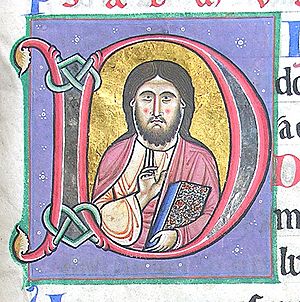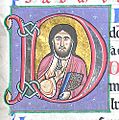Wherwell Abbey facts for kids
| Monastery information | |
|---|---|
| Other names | St. Cross, Wherwell |
| Established | 986 |
| Disestablished | 1539 |
| People | |
| Founder(s) | Ælfthryth, widow of King Edgar, |
| Site | |
| Location | Wherwell, Hampshire, England |
| Coordinates | 51°09′56″N 1°26′30″W / 51.16559°N 1.44171°W |
| Visible remains | none |
Wherwell Abbey was once a home for Benedictine nuns (women who dedicate their lives to God) in Wherwell, a village in Hampshire, England. It was a very important place for many centuries.
Contents
Founding the Abbey
Wherwell Abbey was started around the year 986 by a powerful woman named Ælfthryth. She was the widow of King Edgar. Ælfthryth chose to live at the abbey to show her regret for some difficult events in her past. She passed away there in 1002 and was buried at the abbey.
Soon after Ælfthryth died, her son, King Æthelred the Unready, officially confirmed all the gifts his mother had given to the abbey. At this time, the head nun, called the abbess, was Heanfied. The abbey received land and houses in places like Winchester.
An unnamed granddaughter of Ælfthryth, who was also a daughter of King Æthelred, became abbess in the 1000s.
The Domesday Book, a famous survey from 1086, recorded what the abbey owned. It listed villages like Wherwell, Tufton Goodworth, and Little Anne, along with houses in Winchester. The abbey's yearly income was about £14 and 10 shillings, which was a good amount of money back then.
Abbey's Later Years
During a time of civil war in England called the Anarchy (around 1141), the forces of Empress Matilda used the abbey as a fort. However, King Stephen's soldiers, led by William of Ypres, defeated them. Matilda's men ran into the abbey, and Stephen's troops then burned it down. You can still see traces of the earthworks (like small hills or ditches) that Matilda's forces built around the abbey today.
Around 1173, a nun named Matilda de Bailleul arrived from Flanders. She worked hard to repair the damage caused by the fire. She set up a new way to get money for the abbey. After Thomas a Beckett was murdered in 1173, the abbey gained a silver goblet and a gilded chalice (a special cup) that he had used. Since the abbey didn't have any holy relics, these drinking vessels might have helped attract donations. Matilda also added lighting and beautiful decorations to the abbey.
In 1194, Pope Celestine III wrote to Matilda and the nuns, noting how much the abbey had improved. By then, the abbess owned a special book called a psalter. This book is thought to have been made by scribes and an artist from St Albans Abbey. Matilda added notes about her family and prayers to this psalter.
Matilda died in 1212. By this time, the number of nuns had grown from just a few to forty. Matilda's niece, Euphemia de Walliers, became the next abbess. Matilda's psalter was passed down to the abbesses who came after her, and they also added their own notes. This psalter is now kept at St John's College, Cambridge. Euphemia, like Matilda, came from Flanders. She served as abbess until 1257.
Abbess Euphemia was very energetic and made many improvements. She built new buildings for the nuns, including a sick bay, a dormitory, and latrines with running water. She also built a chapel and a large garden. Near the river, she constructed practical buildings but made sure the nuns could still reach the water. She removed old, risky buildings and built a new hall for the manor court and an efficient new mill. She also rebuilt damaged manor houses in Middleton and Tufton. Euphemia was known for her charity and for welcoming visitors.
She also made the main church more beautiful. This church was a Norman building that had replaced the original Saxon church after the Norman Conquest. Euphemia added crosses, special containers for holy items, precious stones, robes, and books. When the old bell tower fell onto the dormitory, narrowly missing the nuns, she built a new, tall, and handsome replacement. In her old age, she even rebuilt the church's sanctuary (the holiest part) with very deep foundations.
Under Abbess Euphemia, the number of nuns grew significantly, reaching 80. However, the terrible Black Death plague later reduced this number to just a few.
In 1291, the abbey's wealth was valued at a very large sum, showing how important and rich it had become. That same year, Pope Nicholas IV offered special forgiveness to people who visited the Abbey church on certain holy days.
In larger monasteries, the sacristan (the person in charge of church items) had a very important job. At Wherwell, the sacristan received money from special rents. During the time of another abbess named Maud (1333-1340), a list was made of all the valuable items the sacristan looked after. This list included many precious chalices, silver and gilded containers for holy bread, crosses, candlesticks, and censers (for burning incense). These items show that the abbey had a good income and cared deeply about its religious services.
End of the Abbey
After facing difficulties for several years, Wherwell Abbey was forced to close during the Dissolution of the monasteries by King Henry VIII. This happened on November 21, 1539. The abbess received a yearly payment of £40, and the other nuns also received smaller payments.
After the Abbey Closed
The land and buildings of the abbey were originally meant to go to John Kingsmill, the abbess's brother. However, they were actually given to Thomas West, 9th Baron De La Warr, after he asked Thomas Cromwell for them. A new house, called Wherwell Priory, was built on the site of the old abbey.
Wherwell Abbey Today
The original abbey buildings have disappeared over time. But in 1997, archaeologists from Southampton University used special equipment to find the foundations of the abbey. They are located under the lawn of the 18th-century Wherwell Priory house.
Images for kids



